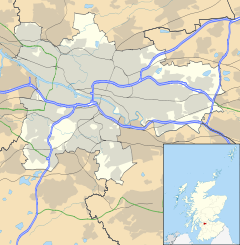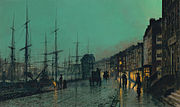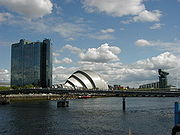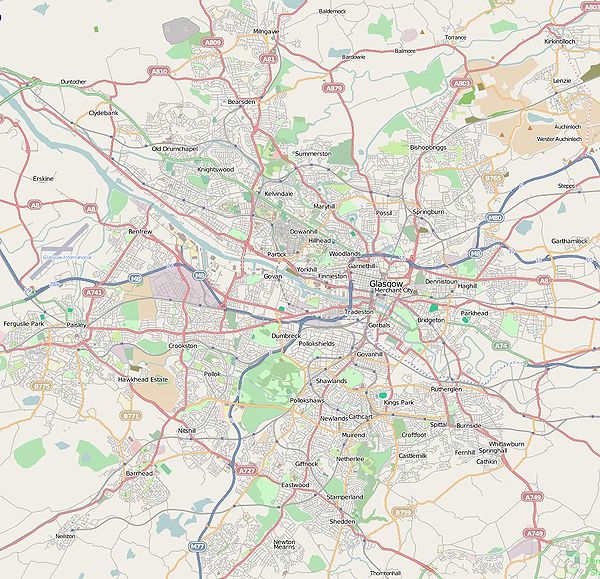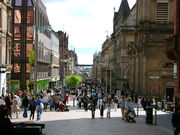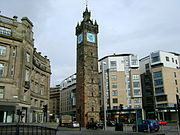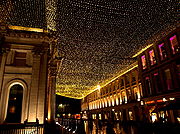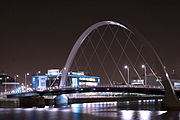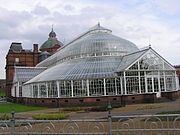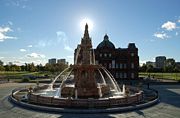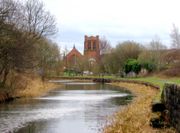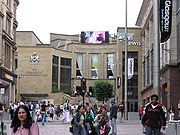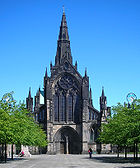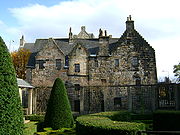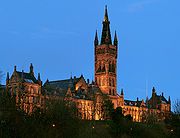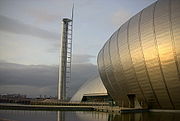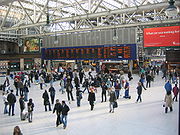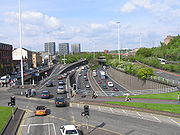
Glasgow
Background to the schools Wikipedia
SOS Children has tried to make Wikipedia content more accessible by this schools selection. A good way to help other children is by sponsoring a child
Coordinates: 55.858°N 4.259°W
| Glasgow | |
| Scottish Gaelic: Glaschu | |
| Scots: Glesga | |
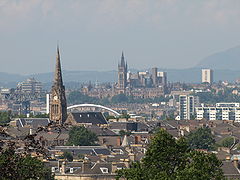 Panorama over western Glasgow from Queen's Park |
|
|
|
|
| Area | 67.76 sq mi (175.5 km2) |
|---|---|
| Population | 580,690 (2006) |
| - Density | |
| Urban | 1,750,000 |
| Metro | Est. 2,550,000 |
| Language | English, Scots (see Glasgow Patter) |
| OS grid reference | NS590655 |
| - Edinburgh | 42 mi (68 km) |
| - London | 403 mi (649 km) |
| Council area | Glasgow City Council |
| Lieutenancy area | Glasgow |
| Country | Scotland |
| Sovereign state | United Kingdom |
| Post town | GLASGOW |
| Postcode district | G1–G80 |
| Dialling code | 0141 |
| Police | Strathclyde |
| Fire | Strathclyde |
| Ambulance | Scottish |
| EU Parliament | Scotland |
| UK Parliament | Glasgow Central |
| Glasgow East | |
| Glasgow North | |
| Glasgow North East | |
| Glasgow North West | |
| Glasgow South | |
| Glasgow South West | |
| Scottish Parliament | Glasgow |
| Glasgow Anniesland | |
| Glasgow Baillieston | |
| Glasgow Cathcart | |
| Glasgow Govan | |
| Glasgow Kelvin | |
| Glasgow Maryhill | |
| Glasgow Pollok | |
| Glasgow Rutherglen | |
| Glasgow Shettleston | |
| Glasgow Springburn | |
| Website | www.glasgow.gov.uk |
|
|
Glasgow ( / ˈ ɡ l æ z ɡ oʊ / GLAZ-goh; Scots: Glesga listen; Scottish Gaelic: Glaschu, pronounced [ˈkɫ̪as̪xu]) is the largest city in Scotland and third most populous in the United Kingdom. The city is situated on the River Clyde in the country's west central lowlands. A person from Glasgow is known as a Glaswegian.
Glasgow grew from the medieval Bishopric of Glasgow and the later establishment of the University of Glasgow in the 15th century, which subsequently became a major centre of the Scottish Enlightenment in the 18th century. From the 18th century the city also grew as one of Britain's main hubs of transatlantic trade with British North America and the British West Indies. With the Industrial Revolution, the city and surrounding region shifted to become one of the world's pre-eminent centres of Heavy Engineering, most notably in the Shipbuilding and Marine engineering industry, which produced many innovative and famous vessels. Glasgow was known as the " Second City of the British Empire" for much of the Victorian era and Edwardian period. Today it is one of Europe's top twenty financial centres and is home to many of Scotland's leading businesses. Glasgow is also ranked as the 57th most liveable city in the world.
In the late 19th and early 20th centuries Glasgow grew to a population of over one million, and was the fourth-largest city in Europe, after London, Paris and Berlin. In the 1960s, large-scale relocation to new towns and peripheral suburbs, followed by successive boundary changes, have reduced the current population of the City of Glasgow unitary authority area to 580,690, with 1,199,629 people living in the Greater Glasgow urban area. The entire region surrounding the conurbation covers approximately 2.3 million people, 41% of Scotland's population.
History
Early origins and development

The present site of Glasgow has been used since prehistoric times for settlement due to it being the furthest downstream fording point of the River Clyde, at the point of its confluence with the Molendinar Burn. The origins of Glasgow as an established city derive ultimately from its medieval position as Scotland's second largest bishopric. Glasgow increased in importance during the 10th and 11th centuries as the site of this bishopric, reorganised by King David I of Scotland and John, Bishop of Glasgow.
There had been an earlier religious site established by Saint Mungo in the 6th century. The bishopric became one of the largest and wealthiest in the Kingdom of Scotland, bringing wealth and status to the town. Between 1175 and 1178 this position was strengthened even further when Bishop Jocelin obtained for the episcopal settlement the status of Royal burgh from King William I of Scotland, allowing the settlement to expand with the benefits of trading monopolies and other legal guarantees. Sometime between 1189 and 1195 this status was supplemented by an annual fair, which survives to this day as the Glasgow Fair.
Glasgow grew over the following centuries, the first bridge over the River Clyde at Glasgow was recorded from around 1285, giving its name to the Briggait area of the city, forming the main North-South route over the river via Glasgow Cross. The founding of the University of Glasgow in 1451 and elevation of the bishopric to become the Archdiocese of Glasgow in 1492 also increased the town's religious and educational status.
Daniel Defoe visited the city in the early 18th century and famously opined in his book A tour thro' the Whole Island of Great Britain, that Glasgow was "the cleanest and beautifullest, and best built city in Britain, London excepted." At that time, the city's population numbered approximately 12,000, and was yet to undergo the massive changes to the city's economy and urban fabric, brought about by the influences of the Scottish Enlightenment and Industrial Revolution.
Trading port
After the Acts of Union in 1707, Scotland gained trading access to the vast markets of the British Empire and Glasgow became prominent in international commerce as a hub of trade to the Americas, especially in the movement of tobacco, cotton and sugar into the deep water port that had been created by city merchants at Port Glasgow on the Firth of Clyde, due to the shallowness of the river within the city itself at that time. By the late 18th century more than half of the British tobacco trade was concentrated on Glasgow's River Clyde, with over 47,000,000 lb (21,000,000 kg) of tobacco being imported at its peak.
Industrialisation
In its subsequent industrial era, Glasgow produced textiles, chemicals, engineered goods and steel, which were exported. The opening of the Monkland Canal and basin at Port Dundas in 1795, facilitated access to the iron-ore and coal mines in Lanarkshire. After extensive River engineering projects to dredge and deepen the River Clyde as far as Glasgow, shipbuilding became a major industry on the upper stretches of the river, building many famous ships (although many were actually built in Clydebank). The River Clyde then became an important source of inspiration for artists, such as John Atkinson Grimshaw, willing to depict the new industrial era and the modern world. Glasgow's population had surpassed that of Edinburgh by 1821. By the end of the 19th century the city was known as the " Second City of the Empire" and by 1870 was producing more than half Britain's tonnage of shipping and a quarter of all locomotives in the world. During this period, the construction of many of the city's greatest architectural masterpieces and most ambitious civil engineering projects, such as the Loch Katrine aqueduct, Subway, Tramway system, City Chambers, Mitchell Library and Kelvingrove Art Gallery and Museum were being funded by its wealth. The city also held a series of International Exhibitions at Kelvingrove Park, in 1888, 1901 and 1911, with the Empire Exhibition subsequently held in 1938.
The 20th century witnessed both decline and renewal in the city. After World War I, the city suffered from the impact of the Post-World War I recession and from the later Great Depression, this also led to a rise of radical socialism and the " Red Clydeside" movement. The city had recovered by the outbreak of World War II and grew through the post-war boom that lasted through the 1950s. By the 1960s, a lack of investment and innovation led to growing overseas competition in countries like Japan and Germany which weakened the once pre-eminent position of many of the city's industries. As a result of this, Glasgow entered a lengthy period of relative economic decline and rapid de-industrialisation, leading to high unemployment, urban decay, population decline, welfare dependency and poor health for the city's inhabitants. There were active attempts at regeneration of the city, when the Glasgow Corporation published its controversial Bruce Report, which set out a comprehensive series of initiatives aimed at turning round the decline of the city. There are also accusations that the Scottish Office had deliberately attempted to undermine Glasgow's economic and political influence in post-war Scotland by diverting inward investment in new industries to other regions during the Silicon Glen boom and creating the new towns of Cumbernauld, Glenrothes, Irvine, Livingston and East Kilbride, dispersed across the Scottish Lowlands, in order to halve the city's population base.
By the late 1980s, there had been a significant resurgence in Glasgow's economic fortunes. The ' Glasgow's miles better' campaign, launched in 1983, and opening of the Burrell Collection in 1983 and Scottish Exhibition and Conference Centre in 1985 facilitated Glasgow's new role as a European centre for business services and finance and promoted an increase in tourism and inward investment. The latter continues to be bolstered by the legacy of the city's Glasgow Garden Festival in 1988, its status as European City of Culture in 1990, and concerted attempts to diversify the city's economy. This economic revival has persisted and the ongoing regeneration of inner-city areas, including the large-scale Clyde Waterfront Regeneration, has led to more affluent people moving back to live in the centre of Glasgow, fuelling allegations of gentrification. The city now resides in the Mercer index of top 50 safest cities in the world and is considered by Lonely Planet to be one of the world's top 10 tourist cities. Despite Glasgow's economic renaissance, the East End of the city remains the focus of severe social deprivation. A Glasgow Economic Audit report published in 2007 stated that the gap between prosperous and deprived areas of the city is widening. In 2006, 47% of Glasgow's population lived in the most deprived 15% of areas in Scotland, while the Centre for Social Justice reported 29.4% of the city's working-age residents to be "economically inactive". Although marginally behind the UK average, Glasgow still has a higher employment rate than Birmingham, Liverpool and Manchester.
Toponymy
It is common to derive the name Glasgow from the older Cumbric glas cau or a Middle Gaelic cognate, which would have meant green hollow. The settlement probably had an earlier Cumbric name, Cathures; the modern name appears for the first time in the Gaelic period (1116), as Glasgu. It is also recorded that the King of Strathclyde, Rhydderch Hael, welcomed Saint Kentigern (also known as Saint Mungo), and procured his consecration as bishop about 540. For some thirteen years Kentigern laboured in the region, building his church at the Molendinar Burn, and making many converts. A large community developed around him and became known as Glasgu (often glossed as "the dear Green" or "dear green place").
Heraldry
| The coat of arms of the City of Glasgow | |
|---|---|
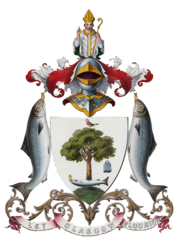 |
|
| Details | |
| Adopted | 1866 |
| Crest | Saint Mungo |
| Supporters | Two salmon, bearing rings |
| Motto | Let Glasgow flourish |
The coat of arms of the City of Glasgow was granted to the royal burgh by the Lord Lyon on 25 October 1866. It incorporates a number of symbols and emblems associated with the life of Glasgow's patron saint, Mungo, which had been used on official seals prior to that date. The emblems represent miracles supposed to have been performed by Mungo and are listed in the traditional rhyme:
-
-
-
- Here's the bird that never flew
- Here's the tree that never grew
- Here's the bell that never rang
- Here's the fish that never swam
-
-
St Mungo is also said to have preached a sermon containing the words Lord, Let Glasgow flourish by the preaching of the word and the praising of thy name. This was abbreviated to "Let Glasgow Flourish" and adopted as the city's motto. The motto was more recently commemorated in a song called "Mother Glasgow", which was written by Dundonian singer/songwriter Michael Marra, but popularised by Hue and Cry.
In 1450, John Stewart, the first Lord Provost of Glasgow, left an endowment so that a "St Mungo's Bell" could be made and tolled throughout the city so that the citizens would pray for his soul. A new bell was purchased by the magistrates in 1641 and that bell is still on display in the People's Palace Museum, near Glasgow Green.
The supporters are two salmon bearing rings, and the crest is a half length figure of Saint Mungo. He wears a bishop's mitre and liturgical vestments and has his hand raised in "the act of benediction". The original 1866 grant placed the crest atop a helm, but this was removed in subsequent grants. The current version (1996) has a gold mural crown between the shield and the crest. This form of coronet, resembling an embattled city wall, was allowed to the four area councils with city status.
The arms were re-matriculated by the City of Glasgow District Council on 6 February 1975, and by the present area council on 25 March 1996. The only change made on each occasion was in the type of coronet over the arms.
Government
Since the Representation of the People Act 1918, Glasgow has increasingly supported Left-wing ideas and politics. The city council has been controlled by the Labour Party for 30 years, since the decline of the Progressives. The left-wing support emanates from the city's legacy as an industrial powerhouse, and the relative poverty of many Glaswegian constituencies and wards. In the aftermath of the Russian Revolution of 1917 and German Revolution, the city's frequent strikes and Militant organisations caused serious alarm at Westminster, with one uprising in January 1919 prompting the Prime Minister, David Lloyd George to deploy 10,000 troops and tanks onto the city's streets. A huge demonstration in the city's George Square on 31 January ended in violence after the Riot Act was read.
Industrial action at the shipyards gave rise to the " Red Clydeside" epithet. During the 1930s, Glasgow was the main base of the Independent Labour Party. Towards the end of the 20th century it became a centre of the struggle against the poll tax, and then the main base of the Scottish Socialist Party, a left unity party in Scotland. The city has not had a Conservative MP since the 1982 Hillhead by-election, when the SDP took the seat, in Glasgow's wealthiest area. Revised constituency boundaries now make it difficult to elect a Conservative MP in Glasgow's prosperous West End because the area is split between two constituencies that include large council estates which predominantly vote Labour.
Scottish Parliament region
The Glasgow electoral region of the Scottish Parliament covers the Glasgow City council area, the Rutherglen area of the South Lanarkshire and a small eastern portion of Renfrewshire. It elects ten of the parliament's 73 first past the post constituency members and seven of the 56 additional members. Both kinds of member are known as Members of the Scottish Parliament (MSPs). The system of election is designed to produce a form of proportional representation.
The first past the post seats were created in 1999 with the names and boundaries of then existing Westminster (House of Commons) constituencies. In 2005, the number of Westminster Members of Parliament (MPs) representing Scotland was cut to 59, with new constituencies being formed, while the existing number of MSPs was retained at Holyrood.
The ten Scottish Parliament constituencies in the Glasgow electoral region are:-
- Glasgow Anniesland
- Glasgow Baillieston
- Glasgow Cathcart
- Glasgow Govan
- Glasgow Kelvin
- Glasgow Maryhill
- Glasgow Pollok
- Glasgow Rutherglen
- Glasgow Shettleston
- Glasgow Springburn
United Kingdom Parliament constituencies
Following reform of constituencies of the House of Commons of the Parliament of the United Kingdom (Westminster) in 2005, which reduced the number of Scottish Members of Parliament (MPs), the current Westminster constituencies representing Glasgow are:-
- Glasgow Central
- Glasgow East
- Glasgow North
- Glasgow North East
- Glasgow North West
- Glasgow South
- Glasgow South West
Geography
Glasgow is located on the banks of the River Clyde, in West Central Scotland. Its second most important river is the Kelvin whose name was used for creating the title of Baron Kelvin and thereby ended up as the scientific unit of temperature. Glasgow is in ancient geographic county of Lanarkshire. For local government Glasgow is a unitary authority.
Location
 |
Renfrew, Dumbarton, Helensburgh, Lochgilphead | Aberfoyle, Callander, Crianlarich | Cumbernauld, Bonnybridge, Falkirk |  |
| Erskine, Paisley, Port Glasgow, Greenock | Coatbridge, Airdrie, Livingston, Edinburgh | |||
| Kilmarnock, Prestwick, Ayr | East Kilbride, Strathaven, Cumnock | Motherwell, Hamilton, Lanark, Hawick |
Climate
In spite of its northerly latitude, close to the same line as Moscow, Glasgow's climate is classified as Oceanic ( Köppen Cfb). Owing to its westerly position and proximity to the sea, Glasgow is one of Scotland's milder areas. Temperatures are usually higher than most places of equal latitude away from the UK, due to the warming influence of the Gulf Stream.
Winters are normally chilly, damp, and overcast, with a January mean of 4.0 °C (39.2 °F), though lows sometimes fall below freezing. Clear or dry days are rare. Snow occurs but rarely lies in the city centre. The spring months (March to May) are generally mild. Many of Glasgow's trees and plants begin to flower at this time of the year and parks and gardens are filled with spring colours. The summer months (June to September) can vary considerably between mild and wet weather or warm and sunny. The warmest month is usually July, with average highs near 20 °C (68 °F). Autumns are cool to mild, with increasing dampness. Extremes range from -20 to 31.2 °C (-4 to 88 °F), the latter occurring 4 August 1975.
| Climate data for Glasgow ( Paisley 32m asl, 1981–2010, extremes 1959–) | |||||||||||||
|---|---|---|---|---|---|---|---|---|---|---|---|---|---|
| Month | Jan | Feb | Mar | Apr | May | Jun | Jul | Aug | Sep | Oct | Nov | Dec | Year |
| Record high °C (°F) | 13.5 (56.3) |
14.4 (57.9) |
17.2 (63) |
24.4 (75.9) |
26.5 (79.7) |
29.6 (85.3) |
30 (86) |
31 (87.8) |
26.7 (80.1) |
22.8 (73) |
17.7 (63.9) |
14.1 (57.4) |
31 (87.8) |
| Average high °C (°F) | 6.9 (44.4) |
7.4 (45.3) |
9.6 (49.3) |
12.6 (54.7) |
15.9 (60.6) |
18.1 (64.6) |
19.7 (67.5) |
19.2 (66.6) |
16.4 (61.5) |
12.7 (54.9) |
9.4 (48.9) |
6.9 (44.4) |
12.9 (55.2) |
| Average low °C (°F) | 1.8 (35.2) |
1.8 (35.2) |
3 (37.4) |
4.8 (40.6) |
7.3 (45.1) |
10.1 (50.2) |
12 (53.6) |
11.7 (53.1) |
9.7 (49.5) |
6.7 (44.1) |
4 (39.2) |
1.7 (35.1) |
6.2 (43.2) |
| Record low °C (°F) | −14.8 (5.4) |
−7.5 (18.5) |
−8.3 (17.1) |
−4.4 (24.1) |
−1.1 (30) |
1.5 (34.7) |
3.9 (39) |
2.2 (36) |
−0.2 (31.6) |
−3.5 (25.7) |
−6.8 (19.8) |
−14.5 (5.9) |
−14.8 (5.4) |
| Rainfall mm (inches) | 148.2 (5.835) |
104.6 (4.118) |
112.3 (4.421) |
63.6 (2.504) |
67.5 (2.657) |
66.4 (2.614) |
73 (2.87) |
92.5 (3.642) |
112.5 (4.429) |
143.1 (5.634) |
126.4 (4.976) |
135.2 (5.323) |
1245.1 (49.02) |
| Avg. rainy days (≥ 1.0 mm) | 17.3 | 13.2 | 14.9 | 11.6 | 11.9 | 11.1 | 12 | 12.8 | 13.8 | 16.8 | 16 | 15.5 | 166.9 |
| Mean monthly sunshine hours | 37.6 | 66.9 | 98.6 | 134.5 | 180.1 | 158.9 | 154.3 | 146.8 | 114.9 | 85.2 | 54 | 33.1 | 1265 |
| Source #1: Met Office | |||||||||||||
| Source #2: KNMI/Royal Dutch Meteorological Institute | |||||||||||||
Demography
The population of the Glasgow City Council area peaked in the 1950s at 1,200,000 people and before that for 80 years was over 1 million. During this period, Glasgow was one of the most densely populated cities in the world. After the 1960s, clearings of poverty-stricken inner city areas like the Gorbals and relocation to ' new towns' such as East Kilbride and Cumbernauld led to population decline. In addition, the boundaries of the city were changed twice during the late 20th century, making direct comparisons difficult. The city continues to expand beyond the official city council boundaries into surrounding suburban areas, encompassing around 400 square miles (1,000 km2) of all adjoining suburbs, if commuter towns and villages are included.
There are two distinct definitions for the population of Glasgow: the Glasgow City Council Area (which lost the districts of Rutherglen and Cambuslang to South Lanarkshire in 1996) and the Greater Glasgow Urban Area (which includes the conurbation around the city).
Since the 1840s to present day, large numbers of Irish immigrants have settled and contributed to the city. At one point only New York City had a bigger Irish population than Glasgow. Huge numbers of Scottish Highlanders also migrated to the city as a result of the Highland Clearances. The Irish and the Scottish Highlanders contributed to the explosive growth of Roman Catholicism in the city.
In the early 20th century, many Lithuanian refugees began to settle in Glasgow and at its height in the 1950s there were around 10,000 in the Glasgow area. Many Italian Scots also settled in Glasgow, originating from provinces like Frosinone between Rome and Naples and Lucca in north-west Tuscany at this time, many originally working as " Hokey Pokey" men. In the 1960s and '70s, many Asian-Scots also settled in Glasgow, mainly in the Pollokshields area. These number 30,000 Pakistanis, 15,000 Indians and 3,000 Bangladeshis as well as Chinese immigrants, many of whom settled in the Garnethill area of the city. Since 2000, the UK government has pursued a policy of dispersal of asylum seekers to ease pressure on social housing in the London area.
| Location | Population | Area | Density | |
|---|---|---|---|---|
| Glasgow City Council | 620,000 | |||
| Greater Glasgow Urban Area | 1,750,270 | |||
| Source: Scotland's Census Results Online | ||||
Since the 2001 census the population decline has stabilised. The 2004 population of the city council area was 685,090 and the population of both the City of Glasgow Council area and Greater Glasgow are forecast to grow in the near future. Around 2,300,000 people live in the Glasgow travel-to-work area. This area is defined as having 10% and over of residents travelling into Glasgow to work, and has no fixed boundaries.
Compared to Inner London, which has ., Scotland's largest city has less than half the current population density of the English capital— In 1931 the population density was , highlighting the subsequent 'clearances' to the suburbs and new towns that were built to empty one of Europe's most densely populated cities.
Glasgow has the lowest life expectancy of any UK city at 72.9 years. Much was made of this during the 2008 Glasgow East by-election. In 2008, a World Health Organization report about health inequalities, revealing that male life expectancy varied from 54 in Calton to 82 in nearby Lenzie, East Dunbartonshire.
Districts and suburbs
The old city of Glasgow originally developed around Glasgow Cathedral and down the old High Street to the River Clyde via Glasgow Cross. The boundaries of Glasgow have changed on several occasions for political purposes, with many places that view themselves as part of Glasgow falling outwith the Glasgow City local authority created in 1996. For further information on what places are within the city council area and those that lie outwith but are included in other definitions of Glasgow, see the List of places in Glasgow page.
City centre
The city centre is bounded by the High Street to the east, the River Clyde to the south and the M8 motorway to the west and north which was built through the Townhead, Charing Cross, Cowcaddens and Anderston areas in the 1960s.
Retail and theatre district
The city centre is based on a grid system of streets on the north bank of the River Clyde. The heart of the city is George Square, site of many of Glasgow's public statues and the elaborate Victorian Glasgow City Chambers, headquarters of Glasgow City Council. To the south and west are the shopping precincts of Argyle Street, Sauchiehall Street and Buchanan Street, the latter featuring more upmarket retailers and winner of the Academy of Urbanism 'Great Street Award' 2008. The main shopping centres are Buchanan Galleries and the St. Enoch Centre, with the up-market Princes Square and the Italian Centre specialising in designer labels. The London-based department store Selfridges purchased a site in the city some years ago as part of its plans to expand stores, plans which have now been shelved according to the company. Glasgow's retail portfolio forms the UK's second largest and most economically important retail sector after Central London.
The city centre is home to most of Glasgow's main cultural venues: The Theatre Royal (home of Scottish Opera and formerly Scottish Ballet (which now resides in the Tramway theatre)), The Pavilion Theatre, The King's Theatre, Glasgow Royal Concert Hall, Glasgow Film Theatre, Tron Theatre, Gallery of Modern Art (GoMA), Mitchell Library and Theatre, the Centre for Contemporary Arts, McLellan Galleries and The Lighthouse Museum of Architecture. The world's tallest cinema, the eighteen-screen Cineworld is situated on Renfrew Street. The city centre is also home to four of Glasgow's higher education institutions: The University of Strathclyde, The Royal Scottish Academy of Music and Drama, Glasgow School of Art and Glasgow Caledonian University.
Merchant City
To the east is the commercial and residential district of Merchant City. The Merchant City was formerly the residential district of the wealthy city merchants in the 18th and early 19th centuries, particularly the Tobacco Lords from whom many of the streets take their name. As the Industrial Revolution and the wealth it brought to the city resulted in the expansion of Glasgow's central area westward, the original medieval centre was left behind. Glasgow Cross, situated at the junction of High Street, Gallowgate, Trongate and Saltmarket was the original centre of the city, symbolised by its Mercat cross. Glasgow Cross encompasses the Tolbooth Clock Tower; all that remains of the original City Chambers, which was destroyed by fire in 1926. Moving northward up High Street towards Rottenrow and Townhead lies the 15th century Glasgow Cathedral and the Provand's Lordship. Due to growing industrial pollution levels in the mid-to-late 19th century, the area fell out of favour with residents.
From the late 1980s onwards, the Merchant City has been rejuvenated with luxury city centre apartments and warehouse conversions. This regeneration has supported an increasing number of cafés and restaurants. The area is also home to a number of high end boutique style shops and some of Glasgow's most upmarket stores.
The Merchant City is the centre of Glasgow's growing 'cultural quarter', based on King Street, the Saltmarket and Trongate, and at the heart of the annual Merchant City Festival. The area has supported a huge growth in art galleries, the origins of which can be found in the late 80s when it attracted artist-led organisations that could afford the cheap rents required to operate in vacant manufacturing or retail spaces. The artistic and cultural potential of the Merchant City as a 'cultural quarter' was harnessed by independent arts organisations and Glasgow City Council, and the recent development of Trongate 103, which houses galleries, workshops, artist studios and production spaces, is considered a major outcome of the continued partnership between both. The area also contains a number of theatres and concert venues, including the Tron Theatre, the Old Fruitmarket, the Trades Hall, St. Andrews in the Square, Merchant Square, and the City Halls.
Financial district
To the western edge of the city centre, occupying the areas of Blythswood Hill and Anderston, lies Glasgow's financial district, known officially as the International Financial Services District (IFSD), although often irreverently nicknamed by the contemporary press as the "square kilometre" or "Wall Street on Clyde". Since the late 1980s the construction of many modern office blocks and high rise developments have paved the way for the IFSD to become one of the UKs largest financial quarters. With a reputation as an established financial services centre, coupled with comprehensive support services, Glasgow continues to attract and grow new business. Of the 10 largest general insurance companies in the UK, 8 have a base or head office in Glasgow – including Direct Line, Esure, AXA and Norwich Union. Key banking sector companies have also relocated some of their services to commercial property in Glasgow – Resolution, JPMorgan Chase, Abbey, HBOS, Barclays Wealth, Tesco Personal Finance , Morgan Stanley, Lloyds TSB, Clydesdale Bank, BNP Paribas, HSBC and the Royal Bank of Scotland. The Ministry of Defence have several departments and Clydeport, the Glasgow Stock Exchange, Student Loans Company, Scottish Executive Enterprise, Transport and Lifelong Learning Department, BT Group, Scottish Qualifications Authority and Scottish Enterprise also have their headquarters based in the district.
West End
Glasgow's West End refers to the bohemian district of cafés, tea rooms, bars, boutiques, upmarket hotels, clubs and restaurants in the hinterland of Kelvingrove Park, the University of Glasgow, Glasgow Botanic Gardens and the Scottish Exhibition and Conference Centre, especially on the area's main thoroughfare, Byres Road, and on Ashton Lane. The area is popular with tourists, and contains many hotels, including the prestigious One Devonshire Gardens, which has accommodated a number of celebrity guests on visits to the city.
The West End includes residential areas of Hillhead, Dowanhill, Kelvingrove, Kelvinside, Hyndland, and, to an increasing extent, Partick. The name is increasingly being used to refer to any area to the west of Charing Cross. This includes areas such as Scotstoun, Jordanhill, Kelvindale and Anniesland.
The West End is bisected by the River Kelvin which flows from the Kilsyth Hills in the North and empties into the River Clyde at Yorkhill Basin.
The spire of Sir George Gilbert Scott's Glasgow University main building (the second largest Gothic Revival building in Britain) is a major local landmark, and can be seen from miles around, sitting atop Gilmorehill. The university itself is the fourth oldest in the English-speaking world. Much of the city's student population is based in the West End, adding to its cultural vibrancy.
The area is also home to the Kelvingrove Art Gallery and Museum, Hunterian Museum and Art Gallery, Kelvin Hall International Sports Arena, Henry Wood Hall (home of the Royal Scottish National Orchestra) and the Museum of Transport, which is to be rebuilt on a former dockland site at Glasgow Harbour to a design by Zaha Hadid. The West End Festival, one of Glasgow's largest festivals, is held annually in June.
Glasgow is the home of the SECC, the United Kingdom's largest exhibition and conference centre. A major expansion of the SECC facilities at the former Queen's Dock by Foster and Partners is currently planned, including a 12,000 seat arena, and a 5 star hotel and entertainments complex.
East End
The East End extends from Glasgow Cross in the City Centre to the boundary with North and South Lanarkshire. It is home to the famous Glasgow Barrowland Market, popularly known as 'The Barras', Barrowland Ballroom, Glasgow Green, and Celtic Park, home of Celtic FC. Many of the original sandstone tenements remain in this district. The East End was once a major industrial centre, home to Sir William Arrol & Co. and William Beardmore and Company. A notable local employer continues to be the Wellpark Brewery, home of Tennent's Lager.
The Glasgow Necropolis Cemetery was created on a hill above the Cathedral of Saint Mungo in 1831. Routes curve through the landscape uphill to the 62-metre (203 ft) high statue of John Knox at the summit. There are two late 18th century tenements in Gallowgate. Dating from 1771 and 1780, both have been well restored. The construction of Charlotte Street was financed by David Dale, whose former pretensions can be gauged by the one remaining house, now run by the National Trust for Scotland. Further along Charlotte Street there stands a modern Gillespie, Kidd & Coia building of some note. Once a school, it has been converted into offices. Surrounding these buildings are a series of innovative housing developments conceived as 'Homes for the Future', part of a project during the city's year as UK City of Architecture and Design in 1999.
East of Glasgow Cross is the Saint Andrew's Church, the oldest post-Reformation church in Scotland, built in 1739–1757 and displaying a Presbyterian grandeur befitting the church of the city's wealthy tobacco merchants. Also close by is the more modest Episcopalian St. Andrew's-by-the-Green, the oldest Episcopal church in Scotland. The Episcopalian St Andrew's was also known as the "Whistlin' Kirk" due to it being the first church after the reformation to own an organ.
Overlooking Glasgow Green is the façade of Templeton On The Green, featuring vibrant polychromatic brickwork intended to evoke the Doge's Palace in Venice.
The extensive Tollcross Park was originally developed from the estate of James Dunlop, the owner of a local steelworks. His large baronial mansion was built in 1848 by David Bryce, which later housed the city's Children's Museum until the 1980s. Today, the mansion is a sheltered housing complex.
The new Scottish National Indoor Sports Arena, a modern replacement for the Kelvin Hall, is planned for Dalmarnock. The area will also be the site of the Athletes' Village for the 2014 Commonwealth Games, located adjacent to the new indoor sports arena.
To the north of the East End lie the two massive gasometers of Provan Gas Works, which stand overlooking Alexandra Park and a major interchange between the M8 and M80 motorways. Often used for displaying large city advertising slogans, the towers have become an unofficial portal into the city for road users arriving from the north and east.
The East End Healthy Living Centre (EEHLC) was established in mid-2005 at Crownpoint Road with Lottery Funding and City grants to serve community needs in the area. The centre provides service such as sports facilities, health advice, stress management, leisure and vocational classes.
South Side
Glasgow's South Side sprawls out south of the Clyde, covering areas including Gorbals, Toryglen, Govan, Ibrox, Shawlands, Simshill, Strathbungo, Cardonald, Mount Florida, Pollokshaws, Nitshill, Pollokshields, Battlefield, Langside, Govanhill, Crosshill, Cessnock, Mosspark, Kinning Park, Mansewood, Arden, Darnley, Newlands, Deaconsbank, Pollok, Croftfoot, Castlemilk, King's Park, Cathcart, Muirend and Barrhead, Busby, Clarkston, Giffnock, Thornliebank, Netherlee, and Newton Mearns in the East Renfrewshire council area, as well as Cambuslang, East Kilbride, and Rutherglen in the South Lanarkshire council area.
Although predominantly residential, the area does have several notable public buildings including, Charles Rennie Mackintosh's Scotland Street School Museum and House for an Art Lover; the world famous Burrell Collection in Pollok Country Park; Alexander 'Greek' Thomson's Holmwood House villa; the National Football Stadium Hampden Park in Mount Florida, (home of Queens Park FC) and Ibrox Stadium, (home of Rangers FC).
The former docklands site at Pacific Quay on the south bank of the River Clyde, opposite the SECC, is the site of the Glasgow Science Centre and the new headquarters for BBC Scotland and STV Group plc (owner of STV) which have relocated there to a new purpose built digital media campus.
In addition, several new bridges spanning the River Clyde have been built or are currently planned, including the Clyde Arc known by locals as the Squinty Bridge at Pacific Quay and others at Tradeston and Springfield Quay.
The South Side also includes many great parks, including Linn Park, Queen's Park, Bellahouston Park and Rouken Glen Park, and several golf clubs, including the championship course at Haggs Castle. The South Side is also home to Pollok Country Park, which was awarded the accolade of Europe's Best Park 2008. Pollok Park is Glasgow’s largest park and the only country park within the city boundaries. It is also home to Poloc Cricket Club. The name was taken from one of the early spellings of the area, to differentiate it from Pollok Juniors Football Club.
Govan is a district and former burgh in the south-western part of the city. It is situated on the south bank of the River Clyde, opposite Partick. It was an administratively independent Police Burgh from 1864 until it was incorporated into the expanding city of Glasgow in 1912. Govan has a legacy as an engineering and shipbuilding centre of international repute and is home to one of two BAE Systems Surface Ships shipyards on the River Clyde and the precision engineering firm, Thales Optronics. It is also home to the Southern General Hospital, one of the largest teaching hospitals in the country, and the maintenance depot for the Glasgow Subway system.
North Glasgow
North Glasgow extends out from the north of the city centre towards the affluent suburbs of Bearsden, Milngavie and Bishopbriggs in East Dunbartonshire and Clydebank in West Dunbartonshire. The area also contains some of the city's poorest residential areas. Possilpark is one such area, where levels of unemployment and drug abuse continue to be above the national average. Much of the housing in areas such as Possilpark and Hamiltonhill had fallen into a state of disrepair in recent years. This has led to large scale redevelopment of much of the poorer housing stock in north Glasgow, and the wider regeneration of many areas, such as Ruchill, which have been transformed; many run-down tenements have now been refurbished or replaced by modern housing estates. Much of the housing stock in north Glasgow is rented social housing, with a high proportion of high-rise tower blocks, managed by the Glasgow Housing Association.
Maryhill consists of well maintained traditional sandstone tenements. Although historically a working class area, its borders with the upmarket West End of the city mean that it is relatively wealthy compared to the rest of the north of the city, containing affluent areas such as Maryhill Park and North Kelvinside. Maryhill is also home to Firhill Stadium, home of Partick Thistle F.C. since 1909, and the professional Rugby Union team, Glasgow Warriors. The junior team, Maryhill F.C. are also located in this part of north Glasgow.
The Forth and Clyde Canal passes through this part of the city, and at one stage formed a vital part of the local economy. It was for many years polluted and largely unused after the decline of heavy industry, but recent efforts to regenerate and re-open the canal to navigation have seen it rejuvenated.
Sighthill is home to Scotland’s largest asylum seeker community.
A huge part of the economic life of Glasgow was once located in Springburn, where the Saracen Foundry, engineering works of firms like Charles Tennant and locomotive workshops employed many Glaswegians. Indeed, Glasgow dominated this type of manufacturing, with 25% of all the world’s locomotives being built in the area at one stage. It was home to the headquarters of the North British Locomotive Company. Today part of the St. Rollox railway works continues in use as a railway maintenance facility, all that is left of the industry in Springburn.
Culture
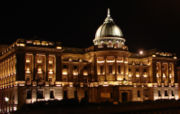
The city has many amenities for a wide range of cultural activities, from curling to opera, ballet and from football to art appreciation; it also has a large selection of museums that include those devoted to transport, religion, and modern art. Many of the city's cultural sites were celebrated in 1990 when Glasgow was designated European City of Culture.
The city's principal library, the Mitchell Library, has grown into one of the largest public reference libraries in Europe, currently housing some 1.3 million books, a extensive collection of newspapers and thousands of photographs and maps.
Most of Scotland's national arts organisations are based in Glasgow, including Scottish Opera, Scottish Ballet, The National Theatre of Scotland, Royal Scottish National Orchestra, BBC Scottish Symphony Orchestra and Scottish Youth Theatre.
Glasgow has its own " Poet Laureate", a post created in 1999 for Edwin Morgan and as of 2007 occupied by Liz Lochhead. Weegie cuisine is famous in Britain for being heavily fatty, with such examples as the deep-fried Mars bar and the Stonner kebab originating from Glasgow.
Recreation
Glasgow is home to a variety of theatres including The King's Theatre, Theatre Royal and the Citizens Theatre and is home to many municipal museums and art galleries, the most famous being the Kelvingrove Art Gallery and Museum, the Gallery of Modern Art (GoMA) and the Burrell Collection. Most of the museums in Glasgow are publicly owned and free to enter.
The city has hosted many exhibitions over the years, including being the UK City of Architecture 1999, European Capital of Culture 1990, National City of Sport 1995–1999 and European Capital of Sport 2003.
In addition, unlike the older and larger Edinburgh Festival (where all Edinburgh's main festivals occur in the last three weeks of August), Glasgow's festivals fill the calendar. Festivals include the Glasgow International Comedy Festival, Glasgow International Jazz Festival, Celtic Connections, Glasgow Fair, Glasgow Film Festival, West End Festival, Merchant City Festival, Glasgay, and the World Pipe Band Championships.
Music scene
Glasgow has many live music venues, pubs, clubs. Some of the city's more well-known venues include the Glasgow Royal Concert Hall, the SECC, King Tut's Wah Wah Hut (where Oasis were spotted and signed by Glaswegian record mogul Alan McGee), the Queen Margaret Union (who have Kurt Cobain's footprint locked in a safe) and the Barrowland, a ballroom converted into a live music venue. More recent mid-sized venues include ABC and the O2 Academy, which play host to a similar range of acts. There are also a large number of smaller venues and bars which host many local and touring musicians, including Stereo, 13th Note and Nice N Sleazy. In 2010, Glasgow was named the UK's fourth 'most musical' City by PRS for Music.
In recent years, the success of bands such as Belle & Sebastian, Camera Obscura, Biffy Clyro, Franz Ferdinand, Mogwai, Snow Patrol and Travis or indie bands such as Primal Scream has significantly boosted the profile of the Glasgow music scene, prompting Time Magazine to liken Glasgow to Detroit during its 1960s Motown heyday. More recent successes include The Fratellis and Glasvegas. The city of Glasgow was appointed a UNESCO City of Music on 20 August 2008 as part of the Creative Cities Network.
Glasgow also has a thriving dance music scene spearheaded by Slam, and their record label Soma Quality Recordings. They're also the people behind the very successful Pressure club nights at The Arches which have attracted DJ's and clubbers from around the world.
The prestigious MOBO Awards were held at the SECC, on 30 September 2009, making Glasgow the first out-of-London city to host the event since its launch in 1995.
Religion
Glasgow is a city of significant religious diversity. The Church of Scotland and the Roman Catholic Church are the two largest Christian denominations in the city. There are 147 congregations in the Church of Scotland's Presbytery of Glasgow (of which 104 are within the city boundaries, the other 43 being in adjacent areas such as Giffnock). The city boasts four Christian cathedrals: Glasgow Cathedral, of the Church of Scotland; St Andrew's Cathedral, of the Catholic Church; St Mary's Cathedral, of the Scottish Episcopal Church, and St Luke's Cathedral, of the Greek Orthodox Church.
The presence of large Protestant and Catholic communities has at times caused the city to experience sectarian tensions. In the past this was, perhaps, mostly visible in the rivalry between the supporters of the city's two major professional football clubs, Celtic F.C. and Rangers F.C.. In the past, Rangers drew its support from the city's Protestant community, while the Roman Catholic population historically supported Celtic.
Biblical unitarians are represented by three Christadelphian ecclesias, referred to geographically, as 'South', 'Central' and 'Kelvin'.
Glasgow Central Mosque in the Gorbals district is the largest mosque in Scotland and, along with twelve other mosques in the city, caters for the city's Muslim population estimated to number 33,000. Glasgow also has a Hindu Mandir, and a planning permission for a new Sikh Temple was submitted in June 2007. This new Temple will complement the existing four Sikh Temples (Gurdwaras) in Glasgow with two in the West End (Central Gurdwara Singh Sabha in Finnieston and Guru Nanak Sikh Temple in Kelvinbridge) and two in the Southside area of Pollokshields (Guru Granth Sahib Gurdwara and Sri Guru Tegh Bahadur Gurdwara). More than 2,000 Sikhs in Glasgow, constituting more than one-third of all Sikhs in Scotland.
Glasgow has seven synagogues with the seventh largest Jewish population in the United Kingdom after London, Manchester, Leeds, Gateshead, Brighton and Bournemouth, but once had a Jewish population second only to London, estimated at 20,000 in the Gorbals alone.
In 1993, the St Mungo Museum of Religious Life and Art opened in Glasgow. It is believed to be the only public museum to examine all the world's major religious faiths.
Dialect
Glaswegian, otherwise known as the Glasgow patter, is a local variety of Scots.
Glaswegian is a dialect, more than an alternative pronunciation; words also change their meaning as all over in Scotland, e.g. "away" can mean "leaving" as in A'm away, an instruction to stop being a nuisance as in away wi ye, or "drunk" or "demented" as in he's away wi it. Ginger is a term for any carbonated soft drink (A bottle o ginger, IPA: [ə ˈboʔl ə ˈdʒɪndʒər]). Then there are words whose meaning has no obvious relationship to that in standard English: coupon means "face", via "to punch a ticket coupon". A headbutt is known in many parts of the British Isles as a "Glasgow kiss", although this term is rarely used by Glaswegians, who say "Malkie" e.g. "ah'll Malkie ye" or "stick the heid/nut on ye".
A speaker of Glaswegian might refer to those originating from the Scottish Highlands and the Western Isles as teuchters, while they would reciprocate by referring to Glaswegians as keelies and those from the East of Scotland refer to Glaswegians as Weegies (or Weedgies).
The long-running TV drama Taggart and the comedies Empty, Chewin' the Fat, Rab C. Nesbitt, Still Game and Dear Green Place depict the Glaswegian patois, while Craig Ferguson and Billy Connolly have made Glaswegian humour known to the rest of the world.
Architecture
Very little of medieval Glasgow remains, the two main landmarks from this period being the 15th century Provand's Lordship and 13th century St. Mungo's Cathedral. The vast majority of the city as seen today dates from the 19th century. As a result, Glasgow has an impressive heritage of Victorian architecture: the Glasgow City Chambers; the main building of the University of Glasgow, designed by Sir George Gilbert Scott; and the Kelvingrove Art Gallery and Museum, designed by Sir John W. Simpson are notable examples.
The city is notable for architecture designed by the Glasgow School, the most notable exponent of that style being Charles Rennie Mackintosh. Mackintosh was an architect and designer in the Arts and Crafts Movement and the main exponent of Art Nouveau in the United Kingdom, designing numerous noted Glasgow buildings such as the Glasgow School of Art, Willow Tearooms and the Scotland Street School Museum. A hidden gem of Glasgow, also designed by Mackintosh, is the Queen's Cross Church, the only church by the renowned artist to be built.

Another architect who had an enduring impact on the city's appearance was Alexander Thomson with notable examples including the Holmwood House villa.
The buildings reflect the wealth and self confidence of the residents of the "Second City of the Empire". Glasgow generated immense wealth from trade and the industries that developed from the Industrial Revolution. The shipyards, marine engineering, steel making, and heavy industry all contributed to the growth of the city.
Many of the city's most impressive buildings were built with red or blond sandstone, but during the industrial era those colours disappeared under a pervasive black layer of soot and pollutants from the furnaces, until the Clean Air Act was introduced in 1956. In recent years many of these buildings have been cleaned and restored to their original appearance.
Modern buildings in Glasgow include the Glasgow Royal Concert Hall, and along the banks of the Clyde are the Glasgow Science Centre and the Scottish Exhibition and Conference Centre, whose Clyde Auditorium was designed by Sir Norman Foster, and is affectionately known as the "Armadillo". Zaha Hadid won a competition to design the new Museum of Transport, which will move to the waterfront.
Glasgow's impressive historical and modern architectural traditions were celebrated in 1999 when the city was designated UK City of Architecture and Design, winning the accolade over Liverpool and Edinburgh.
Housing
Glasgow is known for its tenements. These were the most popular form of housing in 19th and 20th century Glasgow and remain the most common form of dwelling in Glasgow today. Tenements are commonly bought by a wide range of social types and are favoured for their large rooms, high ceilings and original period features. The Hyndland area of Glasgow is the only tenement conservation area in the UK and includes some tenement houses with as many as six bedrooms.
Like many cities in the UK, Glasgow witnessed the construction of high-rise housing in tower blocks in the 1960s, along with large Overspill estates on the periphery of the city, in areas like Pollok, Nitshill, Castlemilk, Easterhouse, Milton and Drumchapel. These were built to replace the decaying inner-city tenement buildings originally built for workers who migrated from the surrounding countryside, the Highlands, and the rest of the United Kingdom, particularly Ireland, in order to feed the local demand for labour. The massive demand outstripped new building and many, originally fine, tenements often became overcrowded and unsanitary. Many degenerated into the infamous Glasgow slums, such as the Gorbals.
Efforts to improve this housing situation, most successfully with the City Improvement Trust in the late 19th century, cleared the slums of the old town areas such as the Trongate, High Street and Glasgow Cross. Subsequent urban renewal initiatives, such as those motivated by the Bruce Report, entailed the comprehensive demolition of slum tenement areas, the development of new towns on the periphery of the city, and the construction of tower blocks.
The policy of tenement demolition is now considered to have been short-sighted, wasteful and largely unsuccessful. Many of Glasgow's worst tenements were refurbished into desirable accommodation in the 1970s and 1980s and the policy of demolition is considered to have destroyed many fine examples of a "universally admired architectural" style. The Glasgow Housing Association took ownership of the housing stock from the city council on 7 March 2003, and has begun a £96 million clearance and demolition programme to clear and demolish many of the high-rise flats.
Healthcare
Medical care is mainly provided by NHS Scotland and is directly administered by NHS Greater Glasgow and Clyde. Major hospitals, including those with Accident & Emergency provision, are: the Western Infirmary, Gartnavel General Hospital and the Royal Hospital for Sick Children in the West End, Glasgow Royal Infirmary and the Dental Hospital in the City Centre, Stobhill Hospital in the North and the Victoria Infirmary and Southern General Hospital in the South Side. There is also an emergency telephone service provided by NHS 24 and 24 hour access to General Practitioners through Out of hours centres. Paramedic services are provided by the Scottish Ambulance Service and supported by voluntary bodies like the St. Andrew's Ambulance Association. A strong Teaching tradition is maintained between the city's main hospitals and the University of Glasgow Medical School.
All Pharmacies provide a wide range of services including minor ailment advice, emergency hormonal contraception, public health aradvice, some provide oxygen and needle exchange.
There are private clinics and hospitals at the Nuffield in the West end and Ross Hall in the South Side of the city.
Academia
Glasgow is a major centre of higher education and academic research, with four universities within 10 miles (16 km) of the city centre:
- University of Glasgow
- Strathclyde University
- Glasgow Caledonian University
- University of the West of Scotland
There are also currently seven further education colleges in the city: Anniesland College, Cardonald College, City of Glasgow College, Stow College, North Glasgow College, John Wheatley College, and Langside College. Higher education colleges in the city include Jordanhill Teacher Training College, the Royal Scottish Academy of Music and Drama and the Glasgow School of Art.
Glasgow is home to a student population in excess of 168,000, the largest in Scotland and second largest in the United Kingdom. The majority of those who live away from home reside in Shawlands, Dennistoun and the West End of the city.
The City Council operates twenty-nine secondary schools, 149 primary schools and three specialist schools – the Dance School of Scotland, Glasgow School of Sport and the Glasgow Gaelic School (Sgoil Ghàidhlig Ghlaschu), the only secondary school in Scotland to teach exclusively in Gaelic. Outdoor Education facilities are provided by the city council at the Blairvadach Centre, near Helensburgh. Jordanhill School is operated directly by the Scottish Government. Glasgow also has a number of Independent schools operating outwith the state sector, such as Fernhill School, St. Aloysius College, Hutchesons' Grammar School, Kelvinside Academy, Glasgow Academy and The High School of Glasgow.
Sport
Football
The world's first international football match was held in 1872 at the West of Scotland Cricket Club's Hamilton Crescent ground in the Partick area of the city. The match, between Scotland and England finished 0–0.
Glasgow is one of only three cities (along with Liverpool in 1985 and Madrid in 1986) to have had two football teams in European finals in the same season: in 1967 Celtic F.C. competed in the European Cup final with Rangers F.C. competing in the Cup Winners' Cup final.
Hampden Park, which is Scotland's national football stadium, holds the European record for attendance at a football match: 149,547 saw Scotland beat England 3-1 in 1937, in the days before leading British stadia became all-seated. Hampden Park has hosted the final of the UEFA Champions League on three occasions, most recently in 2002 and hosted the UEFA Cup Final in 2007. Celtic Park (60,832 seats) is located in the east end of Glasgow, and Ibrox Stadium (51,082 seats) on the south side.
Glasgow has three professional football clubs: Rangers F.C. and Celtic F.C. together known as the Old Firm, and Partick Thistle F.C. A fourth club, Queen's Park F.C., is an amateur club that plays in the Scottish Division 3. Prior to this, Glasgow had five other professional clubs: Clyde F.C., which moved to Cumbernauld, plus Third Lanark A.C., Cambuslang F.C., Cowlairs F.C. and Clydesdale F.C., who all went bankrupt. There are a number of Scottish Junior Football Association clubs within the city as well, such as Pollok F.C., Maryhill F.C., Ashfield F.C. and Petershill F.C., as well as countless numbers of amateur teams.
The history of football in the city, as well as the status of the Old Firm, attracts many visitors to football matches in the city throughout the season. The Scottish Football Association, the national governing body, and the Scottish Football Museum are based in Glasgow, as are the Scottish Football League, Scottish Premier League, Scottish Junior Football Association and Scottish Amateur Football Association. The Glasgow Cup was a once popular tournament, which was competed for by Celtic, Rangers, Clyde, Partick Thistle and Queen's Park. The competition is now played for by the youth sides of the five teams.
| Club | League | Venue | Capacity |
|---|---|---|---|
| Celtic F.C. | Scottish Premier League | Celtic Park | 60,832 |
| Partick Thistle F.C. | Scottish Football League | Firhill Stadium | 10,887 |
| Queen's Park F.C. | Scottish Football League | Hampden Park | 52,670 |
| Rangers F.C. | Scottish Premier League | Ibrox Stadium | 51,082 |
Rugby Union
Glasgow has a professional rugby union club, the Glasgow Warriors, which plays in the Magners League alongside teams from Scotland, Ireland, Wales and Italy.
In the Scottish League, Glasgow Hawks was formed in 1997 by the merger of two of Glasgow's oldest clubs: Glasgow Academicals and Glasgow High Kelvinside (GHK). Despite the merger, the second division teams of Glasgow Academicals and Glasgow High Kelvinside re-entered the Scottish rugby league in 1998.
Another one of Glasgow's old clubs is Cartha Queens Park RFC formed in 1906 as an athletics club rugby has emerged as its principle and now only sport. The club hosts 5 mens playing teams as well as a women's team. They are currently in the BT Premiership third Division.
In the South Glasgow suburb of Giffnock is based another of Glasgow's most prominent clubs Glasgow Hutchesons Aloysians RFC (GHA). GHA was formed in 2002 with the merger of two of Glasgow's leading clubs at the time, Glasgow Southern RFC and Hutchesons' Aloysians RFC.
Rugby League
Glasgow has hosted many Scotland Rugby League Internationals in recent years including last year's World Cup Qualifier Versus Wales in which Scotland qualified for the 2008 Rugby League World Cup on aggregate despite going down by 2 points. Glasgow also regularly hosts Scotland A home games in the Home Nations Cup.
In 2009, a Glasgow based Rugby League team will enter into National League 2. This club will be the first ever semi-pro Scottish Rugby League team. The name and playing venue of the team is yet to be announced. The team will look to follow in the footsteps of Celtic Crusaders and be chosen for a Super League License.
Ice Hockey
Since October 2010 a team called the Braehead Clan based in the Braehead Arena has played in the professional Elite Ice Hockey League alongside two other Scottish teams, the Edinburgh Capitals and the Dundee Stars. This is the first time that a top level ice hockey team has played in Glasgow.
Although still a minority sport in Scotland, Ice Hockey has seen a number of teams based in nearby Paisley, the most famous being the Paisley Pirates.
Swimming
The Arlington Baths Club is the oldest swimming Club in the world and was founded in 1870. The Club in Arlington Street, in the Charing Cross area of the city is still thriving today. It is believed the Club's first Baths Master William Wilson (aquatics) invented Water Polo at the Club. The Arlington's Victorian building is home to a 21M Pool, complete with overhead trapeze and exercise rings. The Arlington inspired other Swimming Clubs and the Western Baths (opened in 1876) is also still in existence in nearby Hillhead. Most of Glasgow's Victorian and Edwardian Pools have been closed or demolished, with the city council investing in large new leisure centres such as Tollcross, Scotstoun or Bellahouston. A community group is hoping to re-open Govanhill Baths, on the city's southside.
Other sports
Major international sporting arenas include the Kelvin Hall and Scotstoun Sports Centre. In 2003 the National Academy for Badminton was completed in Scotstoun. In 2003, Glasgow was also given the title of European Capital of Sport.
Glasgow is also host to many cricket clubs including Clydesdale Cricket Club who have been title winners for the Scottish Cup many times. This club also acted as a neutral venue for a One Day International match between India and Pakistan in 2007, but due to bad weather it was called off.
Smaller sporting facilities include an abundance of outdoor playing fields, as well as golf clubs such as Hagg's Castle and artificial ski slopes. Between 1998 and 2004, the Scottish Claymores American football team played some or all of their home games each season at Hampden Park and the venue also hosted World Bowl XI.
Glasgow Green and the Gorbals are home to a number of rowing clubs, some with open membership the rest belonging to universities or schools. Historically, rowing races on the River Clyde here attracted huge crowds of spectators to watch regattas in the late 19th century and early 20th century; before football caught the public imagination. Two of Glasgow's rowing clubs separately claim that it was their members who were among the founders of Rangers Football Club.
Motorcycle speedway racing was first introduced to Glasgow in 1928 and is currently staged at Saracen Park in the North of the city.
The venues were the Olympic Stadium, also known as Glasgow Nelson (1928 & 1932), Carntyne Stadium (1928 & 1930), White City Stadium (1928–1931, 1939–1940, 1945–1954, 1956, 1964–1968), Celtic Park (1928), Hampden Park (1969–1972), Saracen Park (1949–1953 , 1999 to date), Shawfield Stadium (1988–1998). Details in Speedway in Scotland – Tempus Publishing.
Befitting its strong Highland connections as the City of the Gael Baile Mòr nan Gàidheal, Glasgow is also one of five places in Scotland which hosts the final of the Scottish Cup of Shinty, better known as the Camanachd Cup. This is usually held at Old Anniesland. Once home to numerous Shinty clubs, there is now only one senior club in Glasgow, Glasgow Mid-Argyll, as well as two university sides from University of Strathclyde and University of Glasgow.
2014 Commonwealth Games
On 9 November 2007, Glasgow was selected to be the host city of the 2014 Commonwealth Games. The games will be based on a number of existing and newly constructed sporting venues across the city, including a refurbished Hampden Park, Kelvingrove Park, the Kelvin Hall, and the planned Scottish National Arena at the SECC. The opening ceremony will be held at Celtic Park. Plans have already been drawn up for a Commonwealth Games campus in the east end of the city, which will include a new indoor arena, velodrome and accommodation facilities in Dalmarnock and Parkhead, with an upgraded Aquatics Centre at nearby Tollcross Park. 2014 will be the third time the Games have been held in Scotland.
Economy
Glasgow has the largest economy in Scotland and is at the hub of the metropolitan area of West Central Scotland. Glasgow also has the third highest GDP Per capita of any city in the UK (after London and Edinburgh). The city itself sustains more than 410,000 jobs in over 12,000 companies. Over 153,000 jobs were created in the city between 2000 and 2005 – a growth rate of 32%. Glasgow's annual economic growth rate of 4.4% is now second only to that of London. In 2005, over 17,000 new jobs were created, and 2006 saw private-sector investment in the city reaching £4.2 billion pounds, an increase of 22% in a single year. 55% of the residents in the Greater Glasgow area commute to the city every day. Once dominant export orientated manufacturing industries such as shipbuilding and other heavy engineering have been gradually replaced in importance by more diversified forms of economic activity.
Glasgow was once one of the most significant cities in the UK for manufacturing, which generated a great deal of the city's wealth; the most prominent industry being shipbuilding based on the River Clyde. Although Glasgow owed much of its economic growth to the shipbuilding industry, which still continues today in the form of two shipyards, the city has its roots in the tobacco trade and is noted to have "risen from it's medieval slumber" from trade in tobacco. The city was also noted for its locomotive construction industry, which grew during the 19th century before entering a decline in the 1960s.
Whilst manufacturing has declined, Glasgow's economy has seen significant relative growth of tertiary sector industries such as financial and business services, communications, biosciences, creative industries, healthcare, higher education, retail and tourism. Glasgow is now the second most popular foreign tourist destination in Scotland (fourth in the UK) and its largest retail centre.
Between 1998 and 2001, the city's financial services sector grew at a rate of 30%, making considerable gains on Edinburgh, which has historically been the centre of the Scottish financial sector. Glasgow is now one of Europe's sixteen largest financial centres, with a growing number of Blue chip financial sector companies establishing significant operations or headquarters in the city.
The 1990s and first decade of the 21st century saw substantial growth in the number of call centres based in Glasgow. In 2007 roughly 20,000 people, a third of all call centre employees in Scotland, were employed by Glasgow call centres. This growth and its high use of recruitment agencies to hire graduates as temporary workers has led to accusations of exploitative practices such as long hours, poor pay and lack of job security by the TUC and other union bodies. In recent years some call centres have taken steps to rectify this criticism.
The city's main manufacturing industries include companies involved in; shipbuilding, engineering, construction, brewing and distilling, printing and publishing, chemicals and textiles as well as newer growth sectors such as optoelectronics, software development and biotechnology. Glasgow forms the western part of the Silicon Glen high tech sector of Scotland.
Transport
Public transport
Glasgow has a large urban transport system, mostly managed by the Strathclyde Partnership for Transport (SPT).
The city has many bus services; since bus deregulation almost all are provided by private operators though SPT part-funds some services. The principal bus operators within the city are: First Glasgow, Arriva Scotland West, Stagecoach West Scotland and Glasgow Citybus. The main bus terminal in the city is Buchanan bus station.
Glasgow has the most extensive urban rail network in the UK outside of London with rail services travelling to a large part of the West of Scotland. All trains running within Scotland, including the local Glasgow trains, are operated by First ScotRail, who own the franchise as determined by the Scottish Government. Central Station and Queen Street Station are the two main railway terminals. Glasgow Central is the terminus of the 641.6-kilometre (398.7 mi) long West Coast Main Line from London Euston. All services to and from England use this station. Glasgow Central is also the terminus for suburban services on the south side of Glasgow, Ayrshire and Inverclyde, as well as being served by the cross city link from Dalmuir to Motherwell. Most other services within Scotland – the main line to Edinburgh, plus services to Aberdeen, Dundee, Inverness and the Western Highlands – operate from Queen Street station.
The city's suburban network is currently divided by the River Clyde, and the Crossrail Glasgow initiative has been proposed to link them; it is currently awaiting funding from the Scottish Government. The city is linked to Edinburgh by three direct railway links; a further one, the Airdrie-Bathgate Rail Link, is proposed for completion in 2010. In addition to the suburban rail network, SPT operates the Glasgow Subway. The Subway is the United Kingdom's only completely underground metro system, and is generally recognised as the world's third underground railway after London and Budapest. Both rail and subway stations have a number of park and ride facilities.
As part of the wider regeneration along the banks of the River Clyde, a Pre-Tram System, using dedicated bus lanes, called Clyde Fastlink is currently under construction.
Shipping
Ferries used to link opposite sides of the Clyde in Glasgow but they have been rendered near-obsolete, by bridges and tunnels including the Erskine Bridge, Kingston Bridge, and the Clyde Tunnel. The only remaining crossings are the Renfrew Ferry between Renfrew and Yoker, and the Kilcreggan Ferry in Inverclyde, both run by SPT but outwith the city boundary. The PS Waverley, the world's last operational seagoing paddle-steamer, provides services from Glasgow City Centre, mainly catering to the pleasure cruise market. A regular waterbus service links the City Centre with Braehead in Renfrewshire, some 30 minutes downstream. A service by Loch Lomond Seaplanes, connecting the city with destinations in Argyll and Bute started in 2007. The only operational dock left in Glasgow operated by Clydeport is the King George V Dock, near Braehead. Since the advent of Containerization, most other facilities, such as Hunterston Terminal are located in the deep waters of the Firth of Clyde, which together handle some 7.5 million tonnes of cargo each year.
Roads
The city is the focus of Scotland's trunk road network and has many road connections to other cities. The main M8 motorway passes through the city centre and connects to the M77, M73, and M80 motorways. The A82 connects the city to Argyll and the western Highlands. The M74 runs directly south towards Carlisle; the highly controversial M74 completion scheme will extend the motorway from Tollcross into the Tradeston area to join the M8. A legal challenge to stop the extension was withdrawn in 2006, and the road is now scheduled for completion by 2011.
Other road proposals include the East End Regeneration Route, which aims to provide easier access to deprived areas of the East End.
Airports
The city is served by an two international airports and a seaplane terminal: Glasgow International Airport (GLA) (13 km/8 mi west of the city centre), Glasgow Prestwick International Airport (PIK) and Glasgow Seaplane Terminal, by the Glasgow Science Centre on the River Clyde. There is also a small airfield at Cumbernauld (29 km/18 mi to the north-east) and Glasgow City Heliport located at Stobcross Quay on the banks of the Clyde. A plan to provide a direct rail link to Glasgow International was dropped with the cancelling of the Glasgow Airport Rail Link in 2009. In June 2007, Glasgow International Airport was subject to an attempted terrorist attack.
Twin towns and sister cities
Glasgow is twinned with various cities.
| Country | Place | State / Province / Region / Governorate | Date | |||
|---|---|---|---|---|---|---|
| Germany | Nuremberg | Bavaria | 1985 | |||
| Russia | Rostov-on-Don | Rostov Oblast | 1986 | |||
| People's Republic of China | Dalian | Liaoning | 1997 | |||
| Cuba | Havana | Havana | 2002 | |||
| Italy | Turin | |
Piedmont | 2003 | ||
| Pakistan | Lahore | Punjab | 2006 | |||
| France | Marseille | Provence-Alpes-Côte d'Azur | 2006 | |||
| Palestinian Authority | Bethlehem | Bethlehem Governorate | 2007 |

